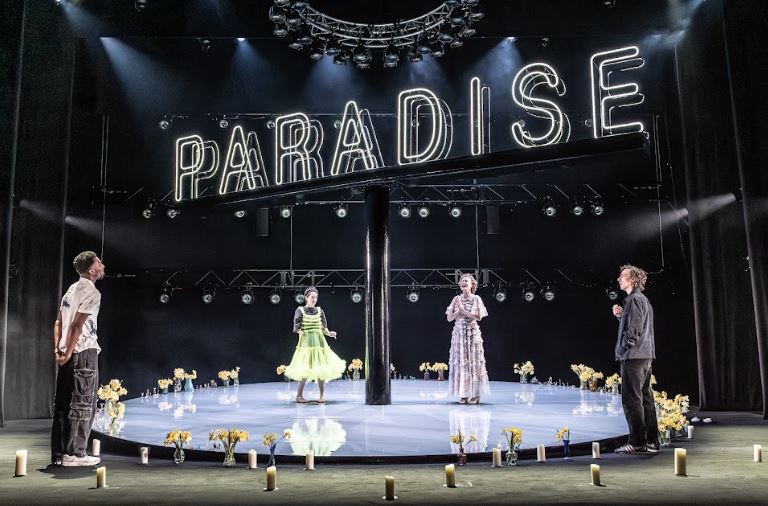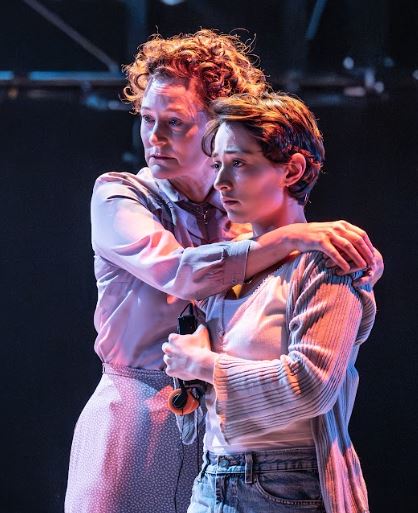The Glass Menagerie
Hypnotic Fragility
The Glass Menagerie
by Tennessee Williams
Rose Theatre, Alexandra Palace, and Belgrade Theatre at The Rose Theatre, Kingston until 4th May, then on tour* until 1st June
Review by Brent Muirhouse
Upon taking a seat in the Rose Theatre, I fell into an instant hypnosis beginning on an empty stage graced with a solitary, central neon sign with the single word, ‘PARADISE’. As the dialogue began, this centrepiece spun as the narrative’s whirling pendulum, and it was clear that audiences would be treated to a mesmerizing interpretation of Tennessee Williams’ classic, The Glass Menagerie. Through a meticulous blend of visual and auditory elements, Atri Banerjee’s direction breathes a zest – an almost steely oxygen – into a tale of family, dreams, and disillusionment taking place in America’s Deep South.
The illuminated beacon serves as a symbolic backdrop against which the Wingfield family’s fragile existence unfolds. Amanda Wingfield (a captivating Geraldine Somerville) is a single mother in a household with daughter Laura (Natalie Kimmerling) and son Tom (Kasper Hilton-Hille), the latter of whom has a dual role as the play’s narrator. The close but often fractious relationships within the family are amplified by these three being the only characters for the majority of the performance, on a stage set up almost ‘in the round’, as the audience peers in to the Wingfield home.

These fragile group dynamics are thrust into testing waters when Tom’s warehouse co-worker, Jim O’Connor (Zacchaeus Kayode) is invited to dinner as an unwitting ‘gentleman caller’ for his sister Laura. As the tension and drama quickens, so does the fluorescent letters’ gyration, mirroring the characters’ escalating emotions and the increasingly susceptible fragility of the ‘glass menagerie’ of Laura’s collectible ornaments, which form a delicate barrier around the stage, enclosing this performance like hands cupped, protective of what lies within. Rosanna Vize’s impact with the design and Lee Curran’s control of the lighting adds depth and texture to the narrative, drawing the audience deeper into the world of the Wingfields, and Williams’ character-driven story.
Accompanying the visual spectacle is a carefully curated soundtrack that heightens the emotional resonance of the play. Music swells during pivotal moments, enveloping the audience in a rich tapestry of sound, particularly on the occasions Laura seeks solace in her stereo Walkman, putting on headphones and retreating into a world of melody and memory to escape the heightening argumentative state between her mother and brother. This juxtaposition of private sanctuary against the backdrop of familial discord underscores the themes of isolation and escapism in Tennessee William’s narrative. These themes are successful due to the fittingly transparent performances from the case: Kimmerling’s Laura aching and timid, Hilton-Hille’s Tom embodying a Holden Caulfield outgoing confidence underpinned by vulnerability, and Geraldine Somerville’s Amanda a masterclass turn swaying from energetic to fatigued, teetering on wearily hopeful. That Jim O’Connor’s belated entrance to the narrative fits the established dynamic so seamlessly is a credit to Zacchaeus Kayode’s warmth and presence in the role.
As the narrative unfolds in the second half, the stage evolves to a simplistic yet evocative candlelit setting, nuancing the vibrancy of the Wingfield household to let the characters confront their inner demons with raw vulnerability. It cannot be overstated how impressive Vize’s set design was to enable the cast’s talent to be displayed at its fullest, and engage the audience in an illuminated performance of what could have otherwise been an inaccessible and terse family drama.

Atri Banerjee’s take on The Glass Menagerie is a true success of both artistry and storytelling. With its innovative staging centring around an almost ethereal, towering luminesce, the letters promised by ‘PARADISE’ fittingly form darker shadows over the cast’s powerful performances, and offers an almost science fiction haze to counteract Williams’ classic American familial setting in 1930’s St. Louis, captivating audiences ‘til the last candle went out and the last word of dialogue rang in the Rose Theatre’s rotunda. The narrative continued to ring around me long after I left the fragility of the glass trinkets behind, as I headed out into the Kingston streets in the April rain, amongst the somewhat less neon glow of the streetlights of suburbia.
Brent Muirhouse, April 2024
Photography by Marc Brenner
* The Glass Menagerie visits:
Rose Theatre — 17th April to 4th May
Bristol Old Vic — 7th to 11th May
Theatre Royal Bath — 13th to 18th May
Alexandra Palace — 22nd May to 1st June

